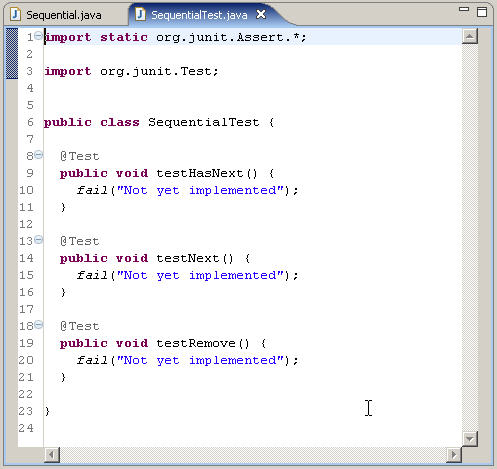import org.junit.*; //For tags import static org.junit.Assert.*; //For assertions
The first imports allows us to have access to the necessary tags (a new feature in Java 1.5), which we will use but not explain below. The second import (with the word static) is also new in Java 1.5; this allows us to use all the methods specified in the Assert class WITHOUT prefacing it with Assert (like calling forInt instead of Prompt.forInt: of course, I named my class and methods to be used together -forInt makes little sense without Prompt prefixing it).- The getStack method exists just to act as a factory method;
this is the only code that constructs a stack, so this method body
determines which implementation of the Stack class were are
testing.
- The setUp method (it can be named anything) is prefaced by the
tab @Before (capitalization is important).
This tag causes this method to be executed before each of the
test methods to be described below.
Note that it initializes one instance variable by constructing a stack,
and intializes three other instance variables.
All these instance variables are used throughout the other test methods.
- The first test method is clear.
It is important to understand that each test method will be run
independently from the others (this is strange, and requires
reflection -something we will discuss later- to accomplish).
For example, if a test method fails an assertion, or even throws an
exception, it will not affect whether subequent tests are run
JUnit takes care of those problems.
The clear method in this class tests the clear method in whatever stack class we are using. Often testers would write this method name as testClear, as does the automatic JUnit generation mechansism in Eclipse. This test is simple: we push three Strings onto the stack and assert that the stack isn't empty; then we exceute the clear method and assert that it is empty.
For compatibility with old JUnits, there are two forms of assertTrue. The one you should use specifies a String describing the error and a boolean expression which, if it doesn't evaluate to true means that an error was detected. You may omit the String argument, just writing a boolean expression, and you will see null instead of the message. We will see where this message is printed in a few minutes.
- Check the API for the Assert class. In includes the method-pairs
assertFalse, assertNonNull, assertNotSame,
assertNull, assertSame, assertTrue, and
fail; it also include a method called assertSame that
is overloaded for all primitive types as well as Object (in a
version with/without a String.
- The second test method is addRemove.
This method first pushes three values on the stack and then ensures that
these same values come off in the reverse order.
Note that the equalsSame method checks for ==: the same
object, not just an .equals one.
It also checks for an empty stack at that point (all values should now
be removed).
We could have checked the size before/after each remove, for an
even finer-grain test.
Finally, it calls remove in a try/catch:
if a NoSuchElementException is caught, the program proceeds
normally (it should have thrown that exception with an empty stack);
but if it doesn't throw this exception, JUnit is explicitly told it
failed a test (which could also be accomplished by the verbose but
equivalent assertTrue("...",false) because false is not
true.
The next group of statements performs the same kind of testing in a more complex context: pushing 1000 integers onto the stack and then popping them off, comparing each popped value for correctness. Notice here that the assertion is assertEquals not assertSame, because we are comparing the popped value against a newly constructed Integer wrapper class object: it is not the same but represents an equal state.
- Before looking at any more tests, lets actually run this JUnit test
and interpret the results.
In the StackTest.java editor tab, right click (on a PC, or
control-click on a Mac) and select Run As and then
JUnit Test (which appears instead of Application).
Here Eclipse is smart enough to know to do something special.
After you run the program, a JUnit tab should appear to the
right of your code as follows.
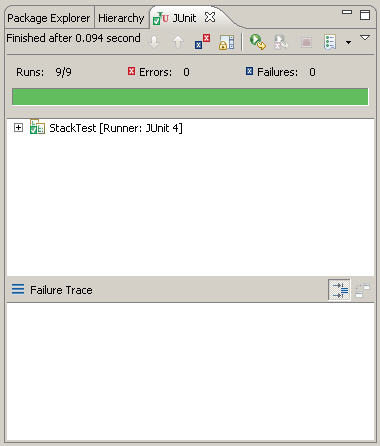
Because it failed no tests, there is a green check on the StackTest icon and Eclipse leaves the individual tests elided (and nothing appears in the Failure Trace pane. Also note the top line of this tab, which reads
Runs: 9/9 Errors: 0 Failures: 0An error means the code threw an uncaught exception; a failure means that one of the assertions was not correct. The green bar beneath it shows the all tests have finished correctly; for very long tests, this serves as the progress bar, filling in left to right. If any tests fail, this bar will appear red not green. We can click on the +StackTest to see the individual tests.
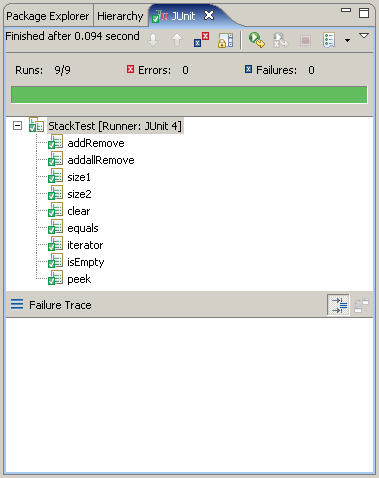
Interestingly, these test appear in no order: neither alphabetical or the order in which the tests are written in the StackTest class.
- Rather than intoduce an error into any queue implementations, we will
write an incorrect test.
Note that JUnit fails to distinguish between whether test code is
incorrect and whether the code being tested is incorrect: so if a test
fails you must double-check that the test is correct and the code is
wrong; if not, debug the test and not the code.
So let's change Line 85 to assert that the size isn't 0 (which is
wrong), and change Line 105 to assertSame (which is wrong: they
are .equals but not ==).
When we run that test we see the following
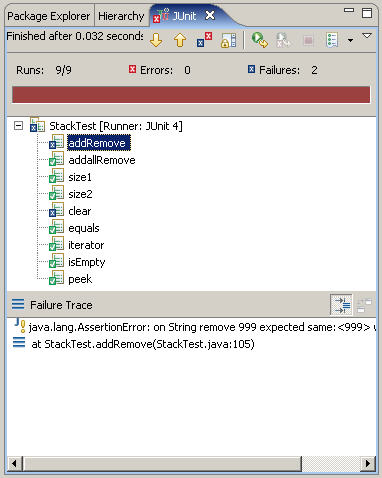
Notice the progress bar appears in red, not green, and the top line indicates Failures: 2. Then the StackTrace icon contains an X and is expanded, showing Xed addRemove and clear methods. The first failed test addRemove is highlighted. In the Failure Trace pane you will the error on the first line and its location in StackTest.jar; if you click the second line, the editor tab for that file will jump to the appropriate line in the test code.
The first line (if you scroll to the right) reads in its entirety
java.lang.AssertionError: on String remove 999 expected same:<999> was not:<999>
IMPORTANT: For any use of a "same" or "equals" method, always put the argument for the correct answer BEFORE the argument for the one that is being tested; otherwise, you will get very confused by the output. IMPORTANT: For this particular case, the output is confusing because the values look the same; but they are not the same, even if they are .equals -remember the difference.Note after a test fails, JUnit terminates the current test method (noting where and why it failed) but continues with all the other tests. In this case, there would have been 999 other failures if the failed test continued to run
Now, click the clear method in the JUnit tab or click the yellow downward arrow. When you do so, you will see the following.
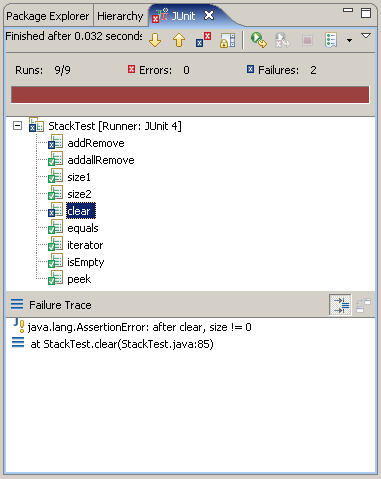
Notice on the first line only the message is printed here (no values). Note that the error messages don't need to indicate which test method they failed in: that is part of the context in which the error message is displayed: the line number on the second line. If you double click the second line, the code in the editor pane will be repositioned to show the line with the failed assertion.
- You can examine the rest of the test as well, although they will not be described any more in this handout. Note that you can terminte the JUnit tab; it will reappear whenever you run the class as a JUnit test. Finally, when you are done, you can remove this project from Eclipse.
